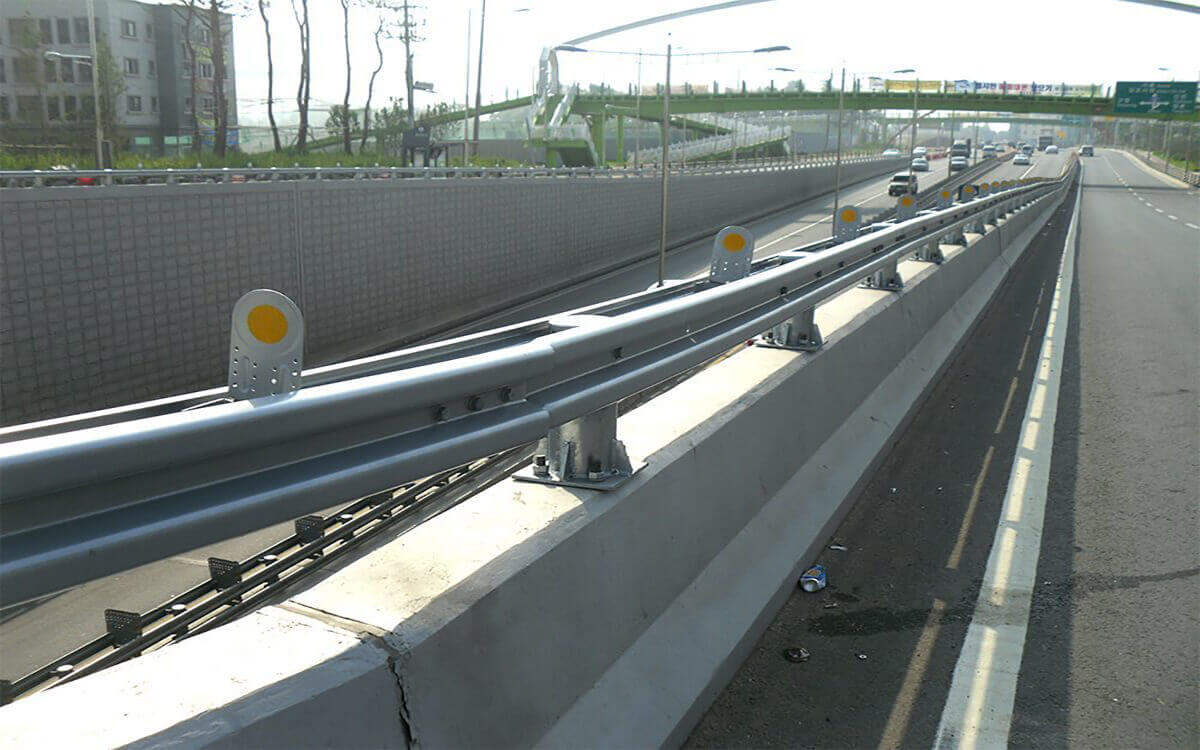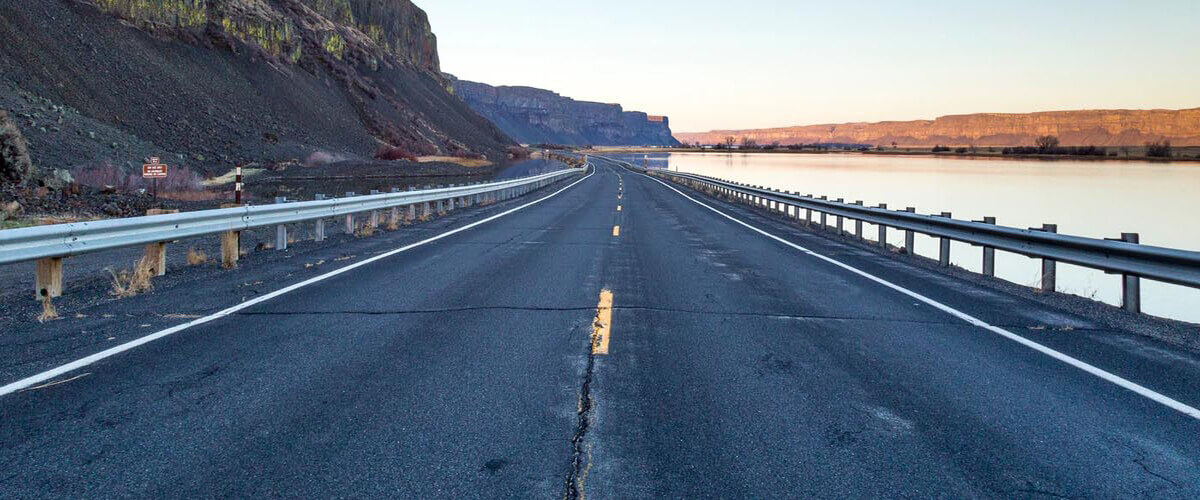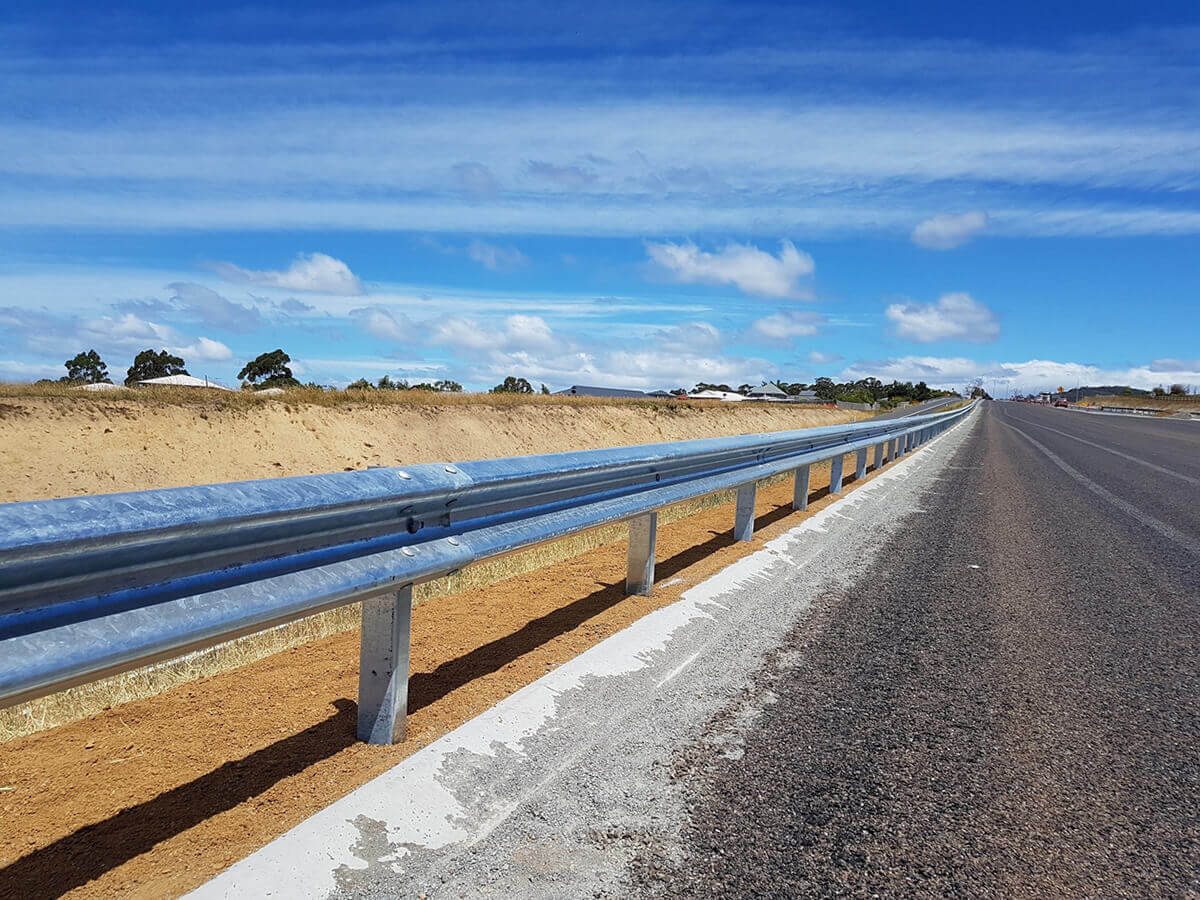Guardrails are a common feature on highways and other roadways, providing a physical barrier between vehicles and hazards such as steep slopes, embankments, and other objects. The purpose of guardrails is to protect motorists and passengers from serious injury or death in the event of a collision or accident. In today’s guide, we’ll look at the types, materials, and costs of highway guardrails. Read on to learn more.
1. Purpose of highway guardrail
Among semi-rigid guardrails, the highway guardrail is the most common. It is a continuous structure with corrugated steel guardrail panels spliced to each other and supported by main columns. During a collision, the vehicle’s ability to absorb energy prevents it from being easily crashed and also provides good protection to the passengers.
The bending of the highway guardrail increases the aesthetics and the strength of the guardrail, achieving both; it is extruded by an automatic production line, with a clean and damage-free surface and strong anti-corrosion properties; mature surface treatment methods; anti-corrosion, anti-aging, and anti-corrosion.
It has the characteristics of resistance to sunlight, high temperature, and low temperature, and its service life in outdoor environments is up to 25 years; the product structure is simple, beautiful, practical, easy to transport and install, has good anti-theft performance, and is less affected by the actual terrain. It is suitable for mountains, slopes, and many bends. The technology is regionally adaptable, moderately expensive, and suitable for large-scale applications.

2. Types of highway guardrails
There are many types of guardrails available on roads, depending on the specific needs of the road and its users. The most common guardrail types include:
- W-shaped steel guardrail: W-shaped steel guardrail is the most common type of guardrail on the road. They consist of a series of steel beams mounted on columns and are designed to absorb the impact of collisions. W-beam guardrails effectively prevent vehicles from driving into oncoming traffic or leaving the road entirely.
- Cable Guardrails: Cable guardrails are another type of guardrail that is becoming increasingly popular on highways and other roadways. They consist of high-voltage cables mounted on poles and are designed to absorb the impact of collisions. Cable barriers effectively prevent vehicles from driving into oncoming traffic or leaving the road entirely.
- Concrete Guardrail: A concrete guardrail is a type of guardrail commonly used on highways and other high-speed roads. They consist of concrete barriers mounted on columns and are designed to absorb the impact of collisions. Concrete barriers can be very effective in preventing vehicles from driving into oncoming traffic or leaving the road entirely.
- Double Traffic Guardrail: Double Traffic Guardrail effectively isolates moving vehicles in the factory area, avoids direct collision, and protects company personnel, equipment, assets, and profits. After impact testing, Aotons’ double-layer traffic guardrail can withstand the impact of a 6-ton forklift at a speed of 9 km/h without being damaged.
- Metal Guardrails: Metal guardrails are the most common type of highway guardrail. They are usually made of steel or aluminum and come in many different designs. The most common design is the W-beam guardrail, which consists of a series of connected W-shaped metal beams. Metal guardrails are often preferred because they are durable and can withstand significant impact.
3. Materials of highway guardrails
Highway guardrails are important safety features designed to protect motorists and minimize the severity of road accidents. These barriers play a vital role in preventing vehicles from veering off the road and reducing the risk of collision with dangerous objects or other vehicles.
While their importance is widely recognized, many people may be curious about the materials used to construct highway guardrails. In the following content, we’ll take a closer look at what highway guardrails are made of, exploring the materials that make them strong, durable, and life-protecting.

1) Steel: pillars of highway guardrails
Steel is the main material for highway guardrail construction. Its exceptional strength, durability, and impact resistance make it ideal for this critical safety function. Guardrails consist of galvanized steel elements including posts, panels, and railings. Together these components create a powerful barrier system.
Post: Guardrail posts are vertical supports embedded in the ground at specific intervals along the highway. These posts provide stability and act as anchor points for the entire guardrail system. Steel columns are often galvanized to increase corrosion resistance and extend their service life.
Panels and Rails: Guardrail panels and rails are horizontally placed components that connect columns. They act as a primary barrier, absorbing impact and guiding the vehicle away from potential hazards. Made from galvanized steel, these panels and rails are designed to withstand high-energy impacts and remain intact, providing a protective barrier between the road and surrounding obstacles.
2) Galvanizing: prevent corrosion
Galvanizing is a key process for steel components of highway guardrails. Galvanizing involves coating steel with a layer of zinc to protect it from corrosion caused by exposure to elements such as moisture, oxygen, and road salt. This process extends the life of the guardrail and ensures its structural integrity.
During the galvanizing process, guardrail components go through a series of steps. The steel is first cleaned to remove any impurities and then immersed in a bath of molten zinc. Zinc forms a protective layer on steel, creating a barrier against corrosive elements. This galvanized coating acts as a sacrificial layer that corrodes in place of the underlying steel.
As a result, guardrails maintain their strength and structural integrity over the long term, even in harsh environmental conditions.
3) Types of steel used for highway guardrails
- Structural steel: Highway guardrails are usually constructed of structural steel, which has excellent load-bearing capacity. This steel is known for its high strength and elasticity, allowing guardrails to withstand the forces exerted by crashing vehicles.
- High-strength steel: High-strength steel is often used in guardrails because of its excellent strength-to-weight ratio. This steel variant offers increased strength without sacrificing flexibility, allowing the guardrail to effectively absorb impact energy.
- Weathering steel: In some cases, guardrails are constructed from weathering steel (also called weathering steel). Over time, this steel develops a protective layer of rust that acts as a natural barrier against corrosion. Weathering steel is particularly suitable for guardrails in areas with harsh climate conditions.

4) Add-ons and accessories
Highway guardrails often contain additional elements and accessories to increase their effectiveness and visibility.
- Reflective Film: Reflective film is applied to guardrail panels and posts to increase visibility, especially at night or during adverse weather conditions. This reflective material helps drivers see guardrails more clearly, allowing them to stay within designated lanes.
- Final Treatment: Guardrail end treatments are specialized structures designed to reduce the severity of impacts at the beginning and end of a guardrail system. These treatments typically consist of energy-absorbing materials, such as specially designed terminals or impact attenuators, which cushion the force of a crash and keep the vehicle away from potential hazards.
- Separation Systems: In some cases, guardrail systems have a separation feature. These mechanisms allow guardrail components to separate or yield during an impact, thereby reducing the risk of serious damage to the vehicle and injury to the occupants.
In summary, highway guardrails are an important safety feature that protects motorists and helps prevent serious accidents on the road. Made primarily from galvanized steel, these barriers are strong, durable, and impact, and corrosion-resistant.
The galvanizing process ensures long-lasting protection against environmental elements and extends the life of the guardrail. By understanding the materials used in highway guardrails and their structural components, we can understand the engineering behind these critical safety features that protect lives and promote safe travel on the road.
4. Cost of highway guardrails
We mentioned the materials of highway guardrails above, so the cost of guardrails varies depending on the material. However, here is a rough estimate of cost per foot:
Metal Guardrails: Metal guardrails cost anywhere from $10 to $30 per foot. The cost will depend on the specific materials used and the length of barrier required.
Concrete Guardrails: Concrete guardrails cost significantly more than metal guardrails, ranging from $40 to $100 per linear foot. In addition to the complexity of installation, materials are also more expensive.
Installation Cost: Highway guardrail installation costs range from $500 to $1,500 per foot, depending on the complexity of the project. This cost includes the labor required to install the barrier and any additional equipment or materials needed.
Maintenance Cost: Highway guardrail maintenance costs range from $5 to $10 per linear foot per year. In order to maintain the barrier’s condition and ensure it continues to provide adequate protection, regular maintenance such as cleaning and repainting is required.

5. Factors affecting the cost of highway guardrails
The cost of highway guardrails can vary greatly based on a variety of factors. Here are some of the major factors that impact overall cost:
Material: The material used for highway guardrails is one of the most important factors that affect the cost. Metal guardrails are generally less expensive than concrete guardrails, with steel being the most cost-effective option.
Length: The length of the highway guardrail required is another factor that affects the overall cost. The longer the barrier, the more materials and labor required, which drives up costs.
Installation: Installation costs also affect the overall cost of highway guardrails. Installation costs can vary depending on the complexity of the project, including factors such as terrain and access.
Maintenance: Maintenance is another factor to consider when calculating the total cost of highway guardrails. In order to maintain the barrier’s condition and ensure it continues to provide adequate protection, regular maintenance such as cleaning and repainting is required.
Highway guardrails are an important part of road safety, protecting drivers and passengers from dangerous accidents. The cost of highway guardrails can vary greatly depending on the materials used, guardrail length, installation complexity, and maintenance requirements. If you would like to know the cost of the project you want, you can contact Aotons directly for a detailed quote.
6. When are guardrails needed on roads?
Several factors determine whether guardrails are needed on a particular road. These include:
1) Highways
As mentioned earlier, roads with speed limits of 45 mph or higher are more likely to require guardrails. This is because higher speeds increase the risk of serious accidents, and guardrails can help prevent death and serious injury.
2) Curves and steep slopes
Roads with sharp curves and steep slopes are also more likely to require guardrails to prevent accidents. Road geometry can make it difficult for drivers to stay on the road, especially at high speeds or when distracted. Guardrails can provide a physical barrier that helps keep vehicles on the road and prevents them from driving over the edge.
3) Bridges and Overpasses
Bridges and overpasses are another area that often requires guardrails. These structures are often elevated, giving vehicles limited space to maneuver and making them more prone to accidents. Guardrails can help prevent vehicles from hitting the sides of bridges and overpasses and falling off the edge.
4) Steep embankments
In order to maintain the barrier’s condition and ensure it continues to provide adequate protection, regular maintenance such as cleaning and repainting is required. These embankments can be difficult to navigate, especially in poor weather conditions or if the driver is not paying attention. Guardrails can help prevent vehicles from sliding down embankments and provide a physical barrier to protect motorists.
5) Accident History
As mentioned previously, the accident history on a particular roadway is an important factor to consider when determining whether guardrails are needed. If there have been many accidents on a certain stretch of road, it may be necessary to install guardrails to prevent future accidents.
6) Traffic Volume
Another factor that determines whether guardrails are needed is the amount of traffic on the road. Roads with high traffic volumes are more likely to need guardrails because the risk of collisions and accidents is greater.
7) Surrounding environment
A guardrail’s need can also be affected by the environment surrounding the road. For example, if there are buildings or other structures near the road, guardrails may be needed to prevent vehicles from colliding with them.
Providing a physical barrier between vehicles and hazards, guardrails are an essential safety feature on roads and highways. Guardrail installation depends on several factors, including speed limits, traffic volume, road geometry, surroundings, and accident history. The most common types of guardrails include W-shaped steel guardrails, cable guardrails, and concrete guardrails.
If you are driving on a road with a high-speed limit, sharp turns, steep embankments, or a history of accidents, be sure to pay attention to guardrails and drive safely to avoid accidents.

7. Conclusion
The above is the relevant knowledge of highway guardrails summarized in this guide. Guardrails play an important role in road safety. They not only protect the safety of vehicles but also protect the safety of pedestrians. I hope you can learn more about traffic guardrails after reading this article.





Leave A Comment